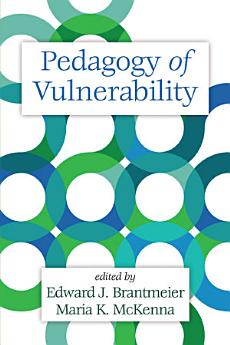Pedagogy of Vulnerability
Edward J. Brantmeier · Maria K. McKenna
Mar 2020 · IAP
Ebook
295
Pages
family_home
Eligible
info
reportRatings and reviews aren’t verified Learn More
About this ebook
The purpose of this text is to elicit discussion, reflection, and action specific to pedagogy within education, especially higher education, and circles of experiential learning, community organizing, conflict resolution and youth empowerment work. Vulnerability itself is not a new term within education; however the pedagogical imperatives of vulnerability are both undertheorized in educational discourse and underexplored in practice. This work builds on that of Edward Brantmeier in Re-Envisioning Higher Education: Embodied Pathways to Wisdom and Transformation (Lin, Oxford, & Brantmeier, 2013). In his chapter, “Pedagogy of vulnerability: Definitions, assumptions, and application,” he outlines a set of assumptions about the term, clarifying for his readers the complicated, risky, reciprocal, and purposeful nature of vulnerability, particularly within educational settings. Creating spaces of risk taking, and consistent mutual, critical engagement are challenging at a moment in history where neoliberal forces impact so many realms of formal teaching and learning. Within this context, the divide between what educators, be they in a classroom or a community, imagine as possible and their ability to implement these kinds of pedagogical possibilities is an urgent conundrum worth exploring. We must consider how to address these disconnects; advocating and envisioning a more holistic, healthy, forward thinking model of teaching and learning. How do we create cultures of engaged inquiry, framed in vulnerability, where educators and students are compelled to ask questions just beyond their grasp? How can we all be better equipped to ask and answer big, beautiful, bold, even uncomfortable questions that fuel the heart of inquiry and perhaps, just maybe, lead to a more peaceful and just world? A collection of reflections, case studies, and research focused on the pedagogy of vulnerability is a starting point for this work. The book itself is meant to be an example of pedagogical vulnerability, wherein the authors work to explicate the most intimate and delicate aspects of the varied pedagogical journeys, understandings rooted in vulnerability, and those of their students, colleagues, clients, even adversaries. It is a work that “holds space.”
Rate this ebook
Tell us what you think.
Reading information
Smartphones and tablets
Install the Google Play Books app for Android and iPad/iPhone. It syncs automatically with your account and allows you to read online or offline wherever you are.
Laptops and computers
You can listen to audiobooks purchased on Google Play using your computer's web browser.
eReaders and other devices
To read on e-ink devices like Kobo eReaders, you'll need to download a file and transfer it to your device. Follow the detailed Help Center instructions to transfer the files to supported eReaders.





